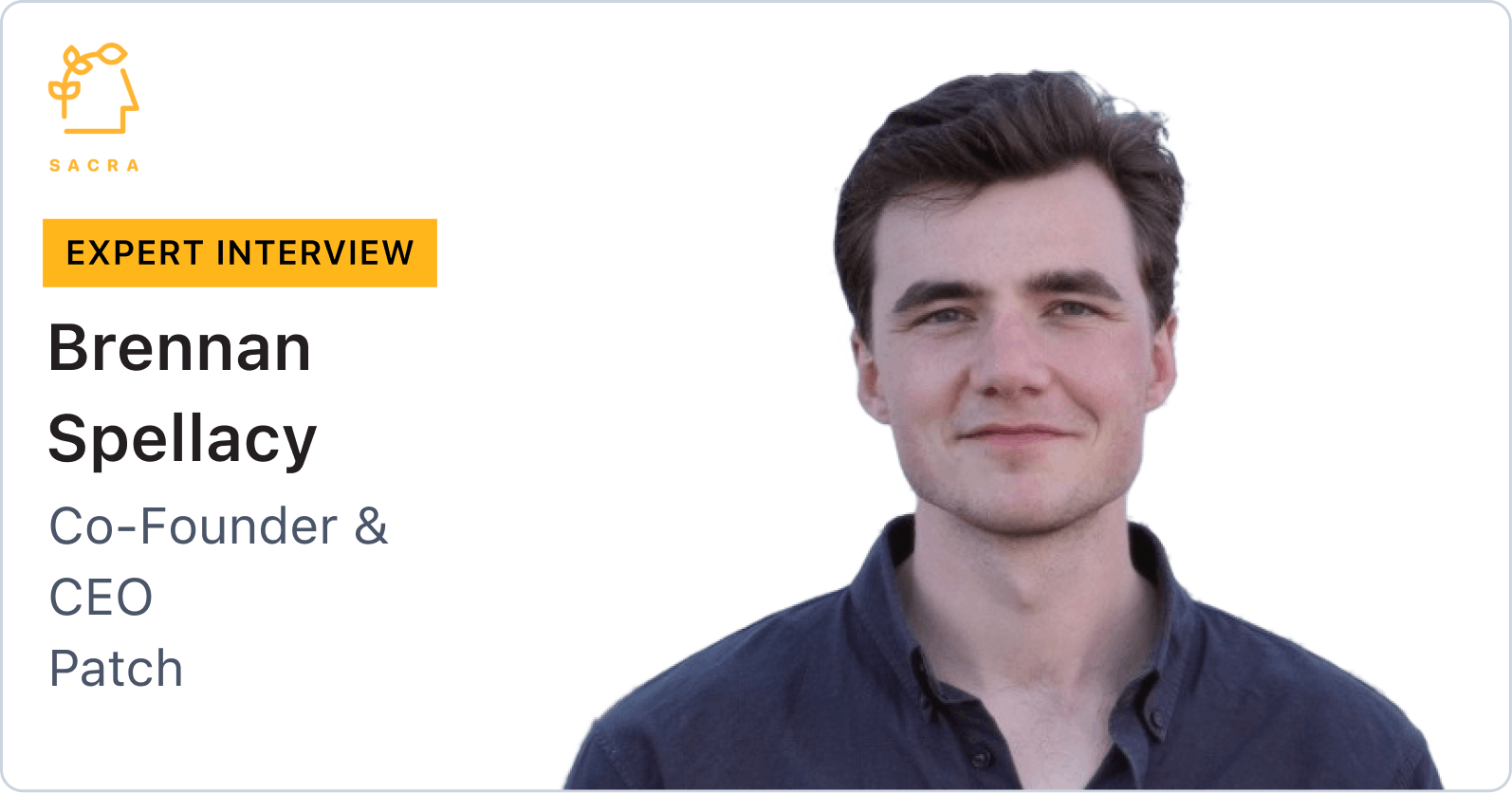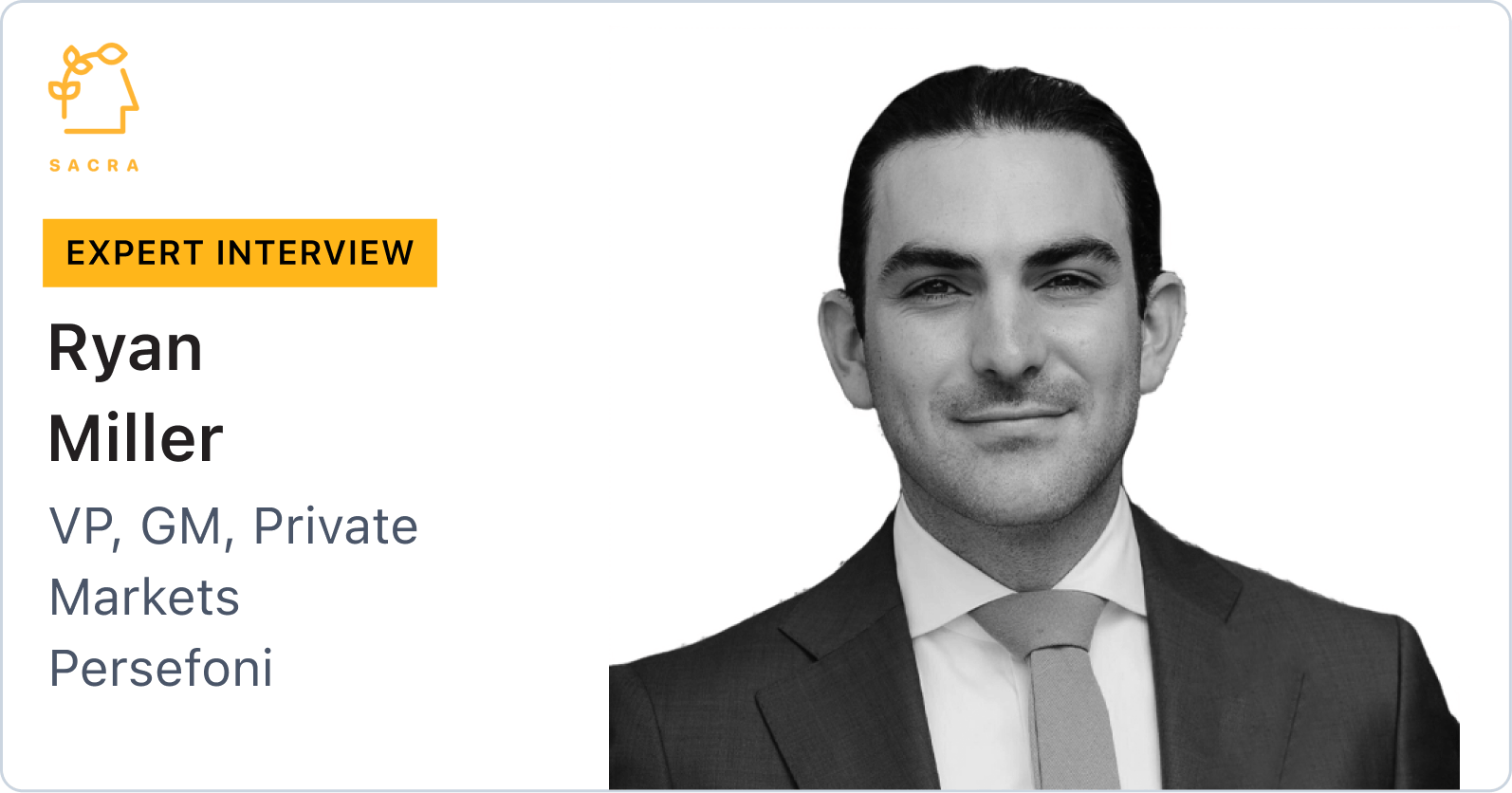Paul Gambill, CEO of Nori, on tokenized projects for social good
 Jan-Erik Asplund
Jan-Erik Asplund

Background
Paul Gambill is the CEO and co-founder of Nori. We talked to Paul to learn more about the market for carbon offsets, the environmental demands of proof-of-work and proof-of-stake, and how tokenization can benefit social action projects.
Questions
- Tell us a bit about Nori, your key use cases and the problem you're solving.
- Why isn’t there enough supply? Is the lack of a good pricing mechanism the key issue?
- Could you take us through your revenue model and the demand side? What do you charge companies that want to offset their carbon footprint via Nori?
- If we were to position Nori in the market of climate products, would it be correct to say that you'd be a Web3 alternative to Web2 products like Patch or Persefoni? Do you see potential for partnerships there or no?
- What does the Nori customer base look like? Among companies going with traditional registries, is that more for compliance reasons or cultural reasons?
- How have people on the supply side of the marketplace responded to the idea of Nori?
- How do you see the regulatory landscape here? A couple weeks ago, there was a new SEC proposal that would require public companies to report their carbon emissions in detail. Do you think these regulations could end up strengthening incumbents like the registries and established players in this market?
- What makes tokenized social impact projects more likely to succeed versus ones that have not succeeded?
- You mentioned crypto protocols as being a really great customer on the demand side. There's considerable talk out there about the environmental impact of crypto. Do you see that as a potential tailwind for Nori?
Interview
Tell us a bit about Nori, your key use cases and the problem you're solving.
Before Nori, I was into software product management and building mobile apps for big Fortune 500 companies at a consulting agency. I wanted to do something bigger.
In 2015, I started looking into climate change and what the climate scientists were saying about the presence of significant quantities of greenhouse gases in the atmosphere. If we could remove enough CO2 from there, we could ease the greenhouse gas effect and effectively solve climate change.
In September 2015, I formed a meetup group in Seattle to research different ways to pull carbon out of the air and connected with four globally scattered groups already working on this. We encountered a moral hazard kind of concern—people felt that if we removed carbon from the air, we’d eliminate the incentive for big emitters to actually deal with their carbon emissions. However, even if one could turn off all sources of carbon emissions, there was far too much carbon around.
Our research on ways to remove massive amounts of carbon revealed nature-based solutions like soil carbon, planting trees, kelp farming, biochar, mangrove restoration etc. along with industrialized approaches like direct air capture, carbon-negative cement, use of other construction materials, and managed mine tailings. However, none of these were happening at significantly large scale. That’s when we realized the need to create incentives to drive this.
In 2011, I got into Bitcoin, crypto and eventually, Ethereum. Over time, inspired by the different carbon removal methods and the tokenized projects taking off in Ethereum, I looked up the carbon offset space to understand how that market worked. Most carbon offsets are not carbon removal but carbon avoidance—they may reduce future emissions, but they don’t deal with past emissions.
I studied analyst reports to understand market size, and realized there was no carbon market! All insights into the volumes of carbon offsets being purchased came only from pretty non-transparent, self-reported surveys. These market volume analyses for primary and secondary sales made me wonder, “Why would you sell the carbon more than once?"
In late 1997 when the Kyoto Protocol was adopted and the Clean Development Mechanism implemented for carbon offset markets, the idea was to have developed countries pay the developing countries for their carbon assets. For example, the U.S. would pay Brazil to keep the Amazon the way it is. That was seen as an equitable wealth transfer. But who were we to dictate how they should develop? That’s when carbon trading emerged as a resolution.
There’d be a market-oriented way to do it with a tradable commodity asset so that price discovery and capital markets could be facilitated around it. This is how the different commodity markets that underpin our entire economy work. In practice, however, it meant that that carbon traded was the carbon credit itself which got sold and resold. It didn’t make sense to me for carbon to be sold more than once. It should be like a consumable good. We should be designing our systems so that every new dollar spent results in net new carbon that's coming out of the air.
Carbon offsets, historically, have worked via these nonprofit carbon offset registries who are arbiters of carbon credits. They certify projects. You need to develop a protocol with them and that costs money. A subsequent validation step involves hiring an environmental science company to build a model that indicates how much carbon you're avoiding or reducing as part of your project. Once the project’s complete, it’s verified by another environmental science company which checks if you’re adhering to the protocol developed earlier. Eventually, the registry issues carbon credits to you. You can sell those to a broker who sells them further till eventually, the carbon credits are sold to an end buyer, and finally, sometimes, retired.
In the secondary trading market, every one of those trades that happen before retirement is part of a much larger secondary volume. In 2016, when tokenization started, I realized we could use cryptocurrency for this, redesign how these carbon offset markets worked, and create incentives to accelerate the rate at which carbon was pulled out of the air. That was the light-bulb moment for what became Nori.
The company was founded in the fall of 2017. We won the Blockchain for Social Impact Hackathon, and very quickly focused on regenerative agriculture since that’s by far the most affordable and scalable method of pulling carbon out of the air available to the world today. Globally, crop lands could support maybe five billion tonnes of CO2 removed every year. American crop lands could do about 400 million tonnes every year. It's quite significant considering that we emit about 50 billion tonnes of CO2 equivalent every year.
At Nori, our tagline is, "Emit less, remove the rest," meaning decarbonize. While there are considerable efforts underway to decarbonize different areas of the economy, you're never going to be able to get that fully to zero. We have to remove the rest to pay a carbon debt of 1.5 trillion tonnes of CO2. From a reversing climate change standpoint, what we need then is a metaphorical factory that can remove between 50-100 billion tonnes of CO2 every year.
At Nori, our mission is to facilitate these markets, accelerate the rate at which new suppliers enter and remove more carbon, and then, have companies that want to be carbon neutral or carbon negative pay them. On the demand side, we want to be Stripe for carbon removal payments and integrate our API into other platforms and applications.
That's the general overview of what Nori is. We look like a carbon credit company but we're really a carbon price discovery company. What’s important is facilitating the price because there isn't a single agreed upon reference price.
If you want to know the price of oil for instance, you look at Brent Crude or WTI. We want people to look at the NORI token similarly.
The way that this works is when a farmer removes carbon and stores it, it gets quantified via a third-party we work with. They use a USDA platform to deduce the amount of carbon in the soil. Then, we issue an asset called the Nori Carbon Removal Tonne (NRT) where one NRT equals one tonne of CO2 sequestered for at least 10 years. The farmer signs a 10-year contract that’s re-verified every three years. So, every third year, they can sell those NRTs and get a new 10-year contract. The NRT to date has just been sold for cash, and we’ve sold about 86,000 tonnes so far, with nearly $1.5 million dollars paid out to farmers. The cash price has been a fairly arbitrary $15 per tonne since 2019.
Our revenue comes from a 15% transaction fee that we charge above that. For financial markets, 15% is significant, but for carbon, big buyers procure offsets by building a large, internal sustainability team with consultants and brokers, so when you add up the costs, 15% is low. The NRTs sold are recorded on the blockchain, immediately made non-transferrable, and retired.
If you can't resell NRTs, then, there’s no tradable commodity asset for price discovery. That's where our NORI token comes in. One NORI equals one NRT, so the NORI price is the price of a tonne of CO2. The buyer pays one NORI, gets one NRT, and the supplier gets one NORI. If he believes the carbon price will rise in future, he holds onto it. If he needs cash flow, he sells it right then.
Similarly, on the demand side, if you’re a savvy CFO that wants to offset perhaps 100,000 tonnes every year for the next three years, then, you’ll buy 300,000 tokens today, lock-in the price, and use them subsequently over each of the next three years. That’s exactly how renewable power purchase agreements are made. The token in effect enables all sorts of financial transactions that don't really exist in the carbon market.
It works on the idea that there’s a finite supply—500 million of them—and they're reusable. The token is like a reusable gift card for a tonne of CO2. When a farmer sells it, it'll go back into circulation and be reused. If the demand for NRTs increases, it hikes the demand for the NORI. However, with a finite supply, if you expect the price to increase, it creates an ever-growing financial incentive for suppliers to newly enter the market.
That's how our flywheel effect of getting more people to remove carbon works because this is a supply side problem, not a demand side one. There is virtually unlimited, infinite demand out there with giant companies indicating they’d buy many orders of magnitude for more carbon removal than is currently available on the market. But the inventory on the shelf is inadequate. That's basically what we are trying to do and how we’re slightly unique.
Why isn’t there enough supply? Is the lack of a good pricing mechanism the key issue?
The problem is all of these different players have developed over time and it's just a very 20th century way of doing things. The offset registries, actually databases of serial numbers, are informed by licensed brokers when carbon credits change hands. While the ownership is manually updated, no one tracks prices or volumes. None of this is transparent or public since you need a license from the registry to see the data. That’s expensive and time-consuming to acquire.
In 2015-16, we started investigating if we should do our own carbon offset project or perhaps even an avoidance project. We could use the funds to develop and bootstrap our carbon removal company. When we delved deeper, it resembled a dairy digester project opportunity which would’ve cost $1.5 million dollars upfront just to get things going. That kind of capex and an additional certification process sounded too expensive.
A lot of offset developers approach big buyers, for example, Microsoft, to help finance this. Microsoft may cover the certification costs and then commit to buying all of their credits over the next 10- or 20 years. It’s a very “insider-y” type of industry, quite bespoke, and not easy for companies with two or three people and limited capital to do. Those are the barriers to entry.
The other unfortunate thing is the nonprofit registries don't have the financial incentives to scale. Their revenue comes from fees they charge on the supply side for registration, listing, transaction, and consulting. In a market that’s supply-constrained, when you put all your fees on the supply side, that won’t increase supply. It's a silly model. That's why we don't charge the suppliers. They pay about $4,000—a 90% reduction relative to what people pay in the traditional registries—for the third-party verification. That’s all.
Could you take us through your revenue model and the demand side? What do you charge companies that want to offset their carbon footprint via Nori?
Our revenue comes from the 15% that we charge above the price. That aligns incentives for both Nori and the suppliers. We want to see the per tonne carbon price increase, because we make more money on a percentage-basis when that happens. If we and the farmers want that, then, our incentives must align to produce that result.
This is unlike brokers or others who’re engaging in carbon offset crediting and how they work. They try to buy carbon from the supply side at the lowest cost possible and then sell it to the demand side at the highest cost possible. The margin between is their take.
We don't work that way. We want the suppliers to get paid as much as possible.
If we were to position Nori in the market of climate products, would it be correct to say that you'd be a Web3 alternative to Web2 products like Patch or Persefoni? Do you see potential for partnerships there or no?
Patch doesn't share information about projects or prices publicly so, it's hard to say anything.
Persefoni and others like them such as Watershed, climateneutral.org or even GreenFeet who we partnered with undertake a carbon footprint analysis for companies. GreenFeet’s clients, when figuring out their carbon footprint, need removals on the backend to get to net zero and that's where we come in. It's quite complementary to our model.
When it comes to the crypto portion of things, we’ve recently partnered with NFT marketplaces, NFT artists, and other protocols. There’s a move-to-earn game, STEP’N, which directs profits towards carbon removal. We’re partnering with them, too. As they succeed, they buy more carbon through us, which is really closer to that API model I described. I think the demand that can come from crypto protocols can actually dwarf demand from Fortune 500 companies. So, if we're building our business models to be dependent upon Fortune 500 companies to solve climate change, it's not going to work. There's just not enough demand there.
Corporations are also difficult to work with because their biggest concern with carbon is an artifact of the way that offset registries have worked in the past. For example, if you're a big enterprise that purchased considerable forestry credits, and then that forest was cut-down or burned down, you're going to get destroyed in the press for it. Corporations see offsetting as a big liability, not just financial but reputational. To counter that, they hire consultants and brokers to do the diligence on these projects and that’s what makes it expensive. Only well-connected, well-financed projects then get off the ground that way. So, they're barriers to growth too, since they insist on such old gatekeeper models.
We accept that registries are too expensive and lack the incentive to change. So, we’ve initiated our own soil carbon methodology based on an open source, peer reviewed, government-run protocol to enable greenhouse gas accounting. Since we're agnostic to different methods of removal, we let market forces determine the most efficient and effective ways for this. The carbon removal industry is going to be huge. Our goal is to capture the market, price it, and have Nori facilitate all the carbon removal.
What does the Nori customer base look like? Among companies going with traditional registries, is that more for compliance reasons or cultural reasons?
Our customer base comprises those who haven't bought carbon before.
Bigger companies go with traditional registries voluntarily, but it’s also cultural and mostly pushed by either their employee activism groups or their consumers. Various surveys indicate that 60-90% of consumers are willing to pay more for sustainable goods and services. This is what the world wants at this point so it's just accepted that companies are going to have to deal with their climate and environmental impacts. That cultural shift happened in late 2018 when the IPCC report was published. That was when Greta Thunberg emerged and the big cultural switch happened.
How have people on the supply side of the marketplace responded to the idea of Nori?
The farmers we work with practice regenerative agriculture that entails reduced tilling, planting cover crops, implementing crop rotations. On average, they can sequester a little over half a tonne of CO2 per acre per year. For them, it's not so much about climate impact as it is about improving soil health and quality, because they're increasing organic matter in the soil, microbes and fungi and that is carbon. Their processes prepare the soil for droughts or floods, eventual increase in crop yields, reduce their dependence upon artificial fertilizer, and lower fuel costs through use of smaller equipment instead of these giant combines that do the heavy plowing in the fall. It's an investment in their future.
Normally, when you switch to regenerative agriculture practices, the overall yields dip for the first few years before they rebound. However, it turns out that paying them for carbon storage is a perfect form of bridge financing to get them through that initial period. So, they do this for their business and get the necessary financing to help. That’s where carbon comes in. Other types of suppliers most often are driven by actual carbon removal. That's what we're doing.
We work with individual farmers and big ag companies who help us collate data about their operations on the farm. As we approach our token launch date, we also see farmers who’ve enrolled themselves, undergone the quantification and verification process and then asked us to hold back some of their NRTs, because they actually want to sell them when the tokens are live. They want to be more involved. They want a piece of this. They understand the economic model.
Crypto might be somewhat new to farmers, generally, but the idea of commodity-based pricing is their whole business. It's new technology but a familiar concept so it isn’t weird or novel for them.
How do you see the regulatory landscape here? A couple weeks ago, there was a new SEC proposal that would require public companies to report their carbon emissions in detail. Do you think these regulations could end up strengthening incumbents like the registries and established players in this market?
There's certainly that risk. The big question around the SEC rule is whether they have the constitutional authority to implement those rules. That’s what should matter.
However, the problem is how does one account for Scope 3 emissions? It's very likely to produce a situation where big companies have to dedicate huge efforts to calculate Scope 3. I think Scope 3 is a dumb idea, because your Scope 3 emissions could be someone’s Scope 1 emissions. Why track it that way?
For what we are trying to accomplish with Nori, it's certainly not necessary. The demand side is not the problem and not enough people understand that. The issue is, how do we make it easier and cheaper for people to remove carbon and get paid for it? That's it.
What makes tokenized social impact projects more likely to succeed versus ones that have not succeeded?
It's just network effects. We'll launch our community on our Discord server that will be opened up for people to join. Once they get there, they’ll want to get involved in a project, perhaps buy and hold tokens, or learn more from farmers who are removing carbon. They'll want to evangelize for this across communities, rope in more people because they have a token that is the carbon price commodity that they can orient themselves around.
Then there’s the ability to plug this into other platforms such as the API model. If this happens automatically and invisibly in the background and the process is friction-free, then there will be increased activity around more carbon being pulled out of the air.
The token is a Schelling point for a community of people who are trying to solve collective action problems. That's what climate change is—a coordinated collective action problem. If you don't have points, objects, commodities, or something with value, for people to orient around, you're not going to progress. That’s why using tokens for coordination is so much more effective than the older, more traditional methods.
You mentioned crypto protocols as being a really great customer on the demand side. There's considerable talk out there about the environmental impact of crypto. Do you see that as a potential tailwind for Nori?
I'll say a couple things. That's definitely what's been driving a lot of the NFT crowd wanting to buy carbon through us and Rarible and The Sandbox and so on. However, there are only two main proof of work blockchains that matter here for this discussion—Bitcoin and Ethereum.
With Ethereum, after the move to proof of stake later in the year, the environmental issue becomes negligible. It's not that big a problem and people need to have some perspective here.
Bitcoin, on the other hand, uses a lot of energy. If you look at it solely as a way for greedy Wall Street and crypto traders to speculate on and make money, then it’ll come across as a waste of energy.
However, if you look at it and think of all the countries under despotic authoritarian regimes that are constantly stealing money from their people and inflating away the value, then, Bitcoin looks like the most democratized form of money on the planet; the most progressive thing; something with real value.
We make value trade-off decisions all the time about energy. For example, clothes dryers in America use more energy than the Bitcoin network. However, we don’t see thought-pieces in magazines about how awful these are. So, there’s that.
Then, there are the incentive structures. Those unfamiliar with crypto or blockchain don't understand that these networks are just going to keep going no matter what. One can get upset about the energy usage, but the incentives are in place such that they will continue onward irrespective of whether you participate in it or not. For example, you could boycott using Ethereum, but that doesn't make a difference. It’ll operate exactly the same way and won’t be that big of a deal. In fact, it’s very solvable.
Bitcoin mining, after China banned it last year, has now moved into North America. A lot of that mining is happening in renewable spaces, because it's cheaper to mine and use renewable energy. Companies like Crusoe Energy, for instance, are using flared methane gas and by burning that, they power Bitcoin miners. There’s less carbon going up in the air. So there are all these different solutions, and the merge, so it’s really not a big deal.
Disclaimers
This transcript is for information purposes only and does not constitute advice of any type or trade recommendation and should not form the basis of any investment decision. Sacra accepts no liability for the transcript or for any errors, omissions or inaccuracies in respect of it. The views of the experts expressed in the transcript are those of the experts and they are not endorsed by, nor do they represent the opinion of Sacra. Sacra reserves all copyright, intellectual property rights in the transcript. Any modification, copying, displaying, distributing, transmitting, publishing, licensing, creating derivative works from, or selling any transcript is strictly prohibited.








